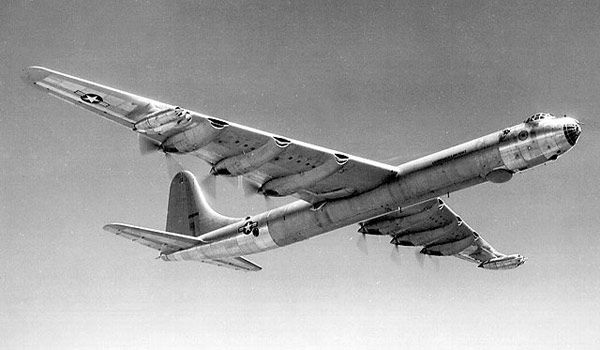B-36 Peacemaker
Summary
| Category | Bombers |
| Origin country | 🇺🇸 United States |
| Manufacturer | Convair |
| First flight | 8 August 1946 |
| Year introduced | 1949 |
| Number produced | 384 units |
| Average unit price | $10 million |
Description
The design of the B-36 can be traced to early 1941, prior to the entry of the United States into World War II, when the possibility existed that Britain might fall to Nazi Germany. This eventuality would have made strategic bombing attacks by the United States Army Air Corps (USAAC) against Germany impossible with existing aircraft, as no available bomber could reach Europe and return to bases in North America. The USAAC sought a bomber with a combat range of at least 5,700 mi (9,200 km). On 11 April 1941, an initial request was issued for a 450 mph (720 km/h) top speed, a 275 mph (443 km/h) cruising speed, a service ceiling of 45,000 ft (14,000 m), and a maximum range of 12,000 mi (19,000 km). On 19 August 1941, the requirements were reduced to a maximum range of 10,000 mi (16,000 km), an effective combat radius of 4,000 mi (6,400 km) with a 10,000 lb (4,500 kg) bomb-load, a cruising speed between 240 and 300 mph (390 and 480 km/h), and a service ceiling of 40,000 ft (12,000 m). Consolidated Vultee Aircraft Corporation (later Convair) won a tender on 16 October 1941, and the aircraft was unveiled on 20 August 1945, flying for the first time on 8 August 1946.
The B-36 featured massive wings, which were 7.5 ft thick and contained a crawlspace for in-flight engine access. These enabled the aircraft to cruise at altitudes above 40,000 ft. Its propulsion system included six 28-cylinder Pratt & Whitney R-4360 Wasp Major radial engines in a pusher configuration, each driving a 19 ft diameter, three-bladed propeller. Beginning with the B-36D variant, four General Electric J47-19 jet engines were added in pods under the wings to improve takeoff and dash speed. The B-36 had a crew of 15. The pressurized flight deck and crew compartment were linked to the rear compartment by a tunnel through the bomb bay. The B-36's tricycle landing gear initially featured single-wheel main landing gear with large tires, which were later replaced by a four-wheeled bogie to reduce ground pressure.
The B-36 could carry up to 87,200 lb (39,600 kg) of bombs across its four bomb bays. The B-36 became the only aircraft capable of delivering the Mark 17 hydrogen bomb until the B-52 became operational. The Mark 17, measuring 25 ft (7.6 m) long and 5 ft (1.5 m) in diameter and weighing 42,000 lb (19,000 kg), occupied two bomb bays, while the forward bay could accommodate a Mark 6 atomic weapon. For defense, the aircraft was equipped with six retractable gun turrets, each with two 20 mm (0.79 in) cannon, totaling 12 guns. All defensive guns were remotely controlled. The aircraft could also carry the T-12 Cloudmaker, a 43,600 lb (19,800 kg) gravity bomb.
The B-36, including its variants such as the GRB-36 and RB-36, was in USAF service as part of the Strategic Air Command (SAC) from 1948 to 1959. RB-36 variants were used for reconnaissance during the Cold War with the Soviet Union. Bomber variants conducted training and test operations and stood ground and airborne alert, but were not flown offensively as bombers against hostile forces. With a range of 9,300 mi (15,000 km), RB-36Ds began probing the Arctic boundaries of the Soviet Union in 1951. Although on-board equipment indicated detection by Soviet radar, interceptions at the B-36's service ceiling remained difficult. RB-36 aircraft operating from RAF Sculthorpe in England made a number of overflights of Soviet Arctic bases, particularly the nuclear weapons test complex at Novaya Zemlya. RB-36s performed reconnaissance missions and frequently penetrated Chinese and Soviet airspace under the direction of General Curtis LeMay.
Main Variants:
-
XB-36: This was the unarmed prototype, powered by six 3,000 hp R-4360-25 engines, serving as the initial testbed for the B-36 concept.
-
B-36A: Serving as an interim, unarmed production variant primarily used for crew training, this model helped familiarize aircrews with the B-36's unique characteristics.
-
B-36D: This model was the same as the B-36B but enhanced with four J47-GE-19 jet engines in underwing pods, augmenting its piston engines for improved performance.
-
RB-36D: This was a strategic reconnaissance variant equipped with camera installations in two bomb bays, allowing for long-range surveillance missions.
-
B-36J: This high-altitude variant featured strengthened landing gear, increased fuel capacity, reduced armament to tail guns only, and a smaller crew, optimizing it for specialized missions.
Technical specifications
| Version: B-36J | |
|---|---|
| Crew | 9 (B-36J) to 22 (RB-36D) |
| Operational range | 6,413 km (3,985 mi) |
| Maximum speed | 673 km/h (418 mph) |
| Wing area | 443.5 m² (4773.8 sqft) |
| Wingspan | 70 m (229.7 ft) |
| Height | 14.3 m (46.8 ft) |
| Length | 49.4 m (162.1 ft) |
| Service ceiling | 13,289 m (43,599 ft) |
| Empty weight | 75,530 kg (166,515 lbs) |
| Max. takeoff weight | 185,973 kg (410,000 lbs) |
| Climb rate | 10.1 m/s (33.1 ft/s) |
| Powerplant | 4 x radial engine Pratt & Whitney R-4360-53 Wasp Major delivering 2359 kgf each |
Current operating countries
All operators
Armament
Bombs payload:
- Thermonuclear Mark 17
